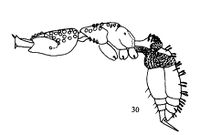Strumigenys dayui
| Strumigenys dayui | |
|---|---|

| |
| Scientific classification | |
| Kingdom: | Animalia |
| Phylum: | Arthropoda |
| Class: | Insecta |
| Order: | Hymenoptera |
| Family: | Formicidae |
| Subfamily: | Myrmicinae |
| Tribe: | Attini |
| Genus: | Strumigenys |
| Species: | S. dayui |
| Binomial name | |
| Strumigenys dayui (Xu, Z., 2000) | |
The type material was collected in monsoon evergreen broad-leaf forest.
Identification
Xu & Zhou (2004) - Xu described and published as a new species in 2000, Bolton (personal communication) considered the names Strumigenys dayui and Strumigenys tisiphone represent the same species. After a careful comparison between the description of P. tisiphone and the holotype worker of E. dayui, we noticed that mandible of the latter without any preapical tooth or denticle, dorsal surface of mandible with only 2 longitudinal rows of scale-like to spoon-shaped hairs, and the measurements are distinctly larger than in the former. And therefore we considered as a valid species which closely related to P. tisiphone.
Xu (2000) - This new species is close to Strumigenys hirashimai, but mandible with slender spine-like teeth, the basal tooth as long as width of masticatory margin; subbasal lobe of antennal scape formed a right angle; in profile view dorsum of alitrunk strongly convex.
Keys including this Species
Distribution
Distribution based on Regional Taxon Lists
Palaearctic Region: China (type locality).
Distribution based on AntMaps
Distribution based on AntWeb specimens
Check data from AntWeb
Countries Occupied
| Number of countries occupied by this species based on AntWiki Regional Taxon Lists. In general, fewer countries occupied indicates a narrower range, while more countries indicates a more widespread species. |

|
Estimated Abundance
| Relative abundance based on number of AntMaps records per species (this species within the purple bar). Fewer records (to the left) indicates a less abundant/encountered species while more records (to the right) indicates more abundant/encountered species. |

|
Biology
Castes
Nomenclature
- dayui. Epitritus dayui Xu, 2000d: 299, figs. 9-12 (w.) CHINA. Combination in Pyramica: Xu & Zhou, 2004: 449; in Strumigenys: Baroni Urbani & De Andrade, 2007: 118.
Unless otherwise noted the text for the remainder of this section is reported from the publication that includes the original description.
Description
Worker
Holotype. TL 2.6, HL 0.63, HW 0.60, CI 96, SL 0.28, SI 46, PW 0. 33, AL 0.70, ED 0.04. Head about as broad as long, anterior-hall distinctly narrower than the posterior half. Occipital margin roundly incised in the middle. Occipital corners rounded. Mandibles slender and roundly curved, masticatory margin with 7 teeth, the basal and apical teeth elongate and spine-like, the basal tooth about as long as the width of the masticatory margin, the apical tooth about as long as half length of the basal one. The other 5 teeth between the basal and apical ones minute. Labrum visible, anterior margin with a pair of cone-like projections. Anterior margin of clypeus nearly straight, slightly convex in the middle. Antenna with 6 segments. Scape depressed, subbasal lobe nearly formed a right angle. The 3rd and 4th segments small and about equal, length of the two segments combined about equal to length of the 2nd and 5th ones. The apical segment very long, about 1.5 times as long as the rest of the flagellum. Eye minute, with 4 facets. Promesonotum relatively flat, mesonotum rounded and lowered down posteriorly. Promesonotal suture fine and distinct. Metanotal groove shallowly depressed. Propodeum slope-like and weakly convex. Propodeal lobe blunt at apex. Dorsum of petiolar node roundly convex. Dorsum of postpetiolar node evenly convex. In dorsal view, petiolar node about square, postpetiolar node broader than long and about semicircular, petiolar node width: postpetiolar node width = 2 : 3. Lateral sides of declivity of propodeum with spongiform longitudinal ridges. Ventral face of petiole, ventral and posterior faces of postpetiole with spongiform appendage. Head, alitrunk and petiolar node densely and finely punctured, dim. Lateral sides of mesonotum and metanotum, postpetiolar node and gaster smooth and shining. Head, mandibles, scapes, alitrunk, petiolar node, dosa of femora and tibiae with circular or subcircular flattened hairs. Lateral sides of pronotum, postpetiolar node and gaster with clavate hairs. Ventral face of head, mandibles, flagella, legs and ventral face of gaster with dense decumbent pubescence. Body in color yellowish brown, gaster dark yellowish brown.
Type Material
Holotype: worker, No. A97-2677, 1380m, monsoon evergreen broad-leaf forest, Nangongshan Mountain, Mengla County, Yunnan Province, 16-IX-1997, collected by XU Zhenghui. Southwest Forestry University, Kunming, China
References
- Baroni Urbani, C. & De Andrade, M.L. 2007. The ant tribe Dacetini: limits and constituent genera, with descriptions of new species. Annali del Museo Civico di Storia Naturale “G. Doria” 99: 1-191.
- Tang, K. L., Guénard, B. 2023. Further additions to the knowledge of Strumigenys (Formicidae: Myrmicinae) within South East Asia, with the descriptions of 20 new species. European Journal of Taxonomy 907, 1–144 (doi:10.5852/ejt.2023.907.2327).
- Xu, Z. 2000d. A new species of the ant genus Epitritus from China. Entomotaxonomia. 22:297-300. [(31).xii.2000.] (page 299, figs. 9-12 worker described)
- Xu, Z. and X. Zhou. 2004. Systematic study on the ant genus Pyramica Roger of China. Acta Zootaxonomica Sinica. 29:440-450.
References based on Global Ant Biodiversity Informatics
- Guénard B., and R. R. Dunn. 2012. A checklist of the ants of China. Zootaxa 3558: 1-77.
- Lu Z., K. Li, N. Zhang, and Y. Chen. 2017. Diversity and indicator species of leaf-litter ants in Eucalyptus grandis plantations and secondary natural forests. Forest Research 29(4): 576-580
- Xu Z. H., and X. G. Zhou. 2004. Systematic study on the ant genus Pyramica Roger (Hymenoptera, Formicidae) of China. Acta Zootaxonomica Sinica 29: 440-450.
- Xu Z. and X.-G. Zhou. 2004. Systematic study on the ant genus Pyramica Roger (Hymenoptera, Formicidae) of China. Acta Zootaxonomica Sinica 29(3): 440-450
